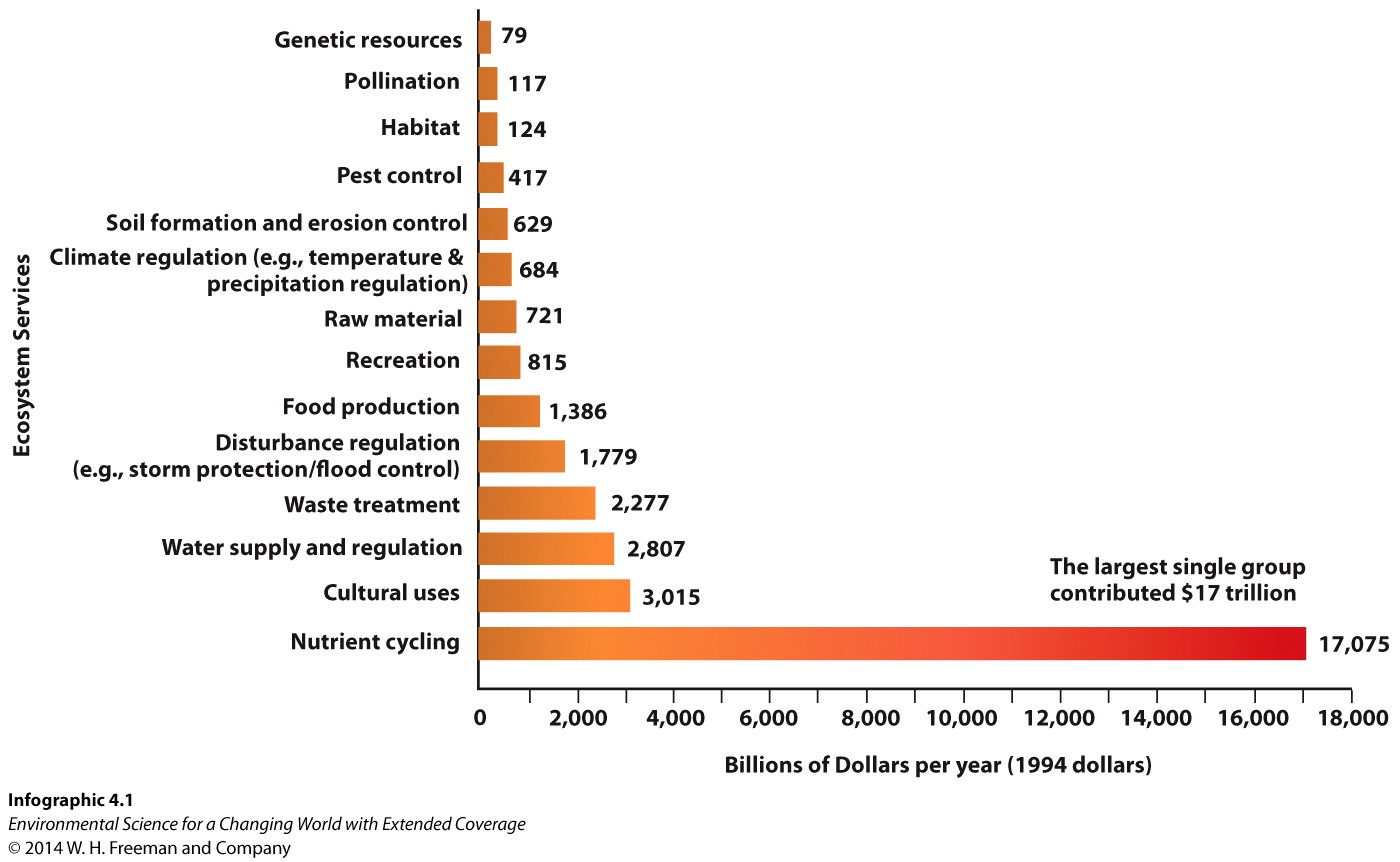What are ecosystem services?
Interactive Study Guide
false
true
Guiding Question 4.1
What are ecosystem services? How can it be useful to place a monetary value on these services, even if we know it will not be accurate?
Why You Should Care
It is hard to imagine all of the ways that the environment around us contributes to our lives. It is easy to measure how much food we eat or how much paper we use, but there are dozens of other contributions that are harder to measure (how much energy goes into making a cell phone, how much land is needed to recycle all the carbon dioxide a person produces, etc.). These contributions are called ecosystem services.
Even if we could accurately measure ecosystem services in terms that made sense (acres of forest, farmland, and wetlands, trees to produce oxygen, etc.), we know that it is hard to measure what value to place on each contribution. Should the forest have more value than wetlands? (And is this because we’re more familiar with forests than swamps?) Can we assign a monetary value to these contributions? Who sets that value? Is a forest in Georgia worth the same as a forest in Brazil?
The process of placing a monetary value on an ecosystem service forces us to recognize the direct importance of sustainable practices for keeping natural systems and ourselves alive. The value may not include every possible aspect, but it reminds and informs our decision-making.
Question
Test Your Vocabulary
Choose the correct term for each of the following definitions:
| Term |
Definition |
|
9RWHXeCyhQ4Zfo32GQ88czyG6145v/z1nQJItWkiJ3DpzwzMDCvXF97exBI6cSJl
|
Essential ecological processes that make life on Earth possible. |
|
BhpDujTqC+ZZnVoUEjB+3tXjhSyvaHdF/wBUwnm/pQQyOlbMdRmDaEWdcHYhlQRG
|
Capable of being continued without degrading the environment. |
|
r/ulD5E/FEZzLS/hSe7333eWG9AgZAZFlB6Kd6x4HQkL35QlTefVjPU7GFGmFEY4
|
The social science that deals with how we allocate scarce resources. |
999
Try again.
Correct.
Incorrect.

Question Sequence
Question
4.1
zICX8yz/tqMxV9hmihZmNQxGfV6O9SMjZT2nVgTn96THaJXcbLYlEVZ0gnJqPu5xxzU0mOPj6/JBLz/mo56uIC0a50OfDi+n3feprf+tUlGxXY6AflSw6YKNWX7AOyQVNCxJyk7rAiOgNuLRusCz0E/pqOwQxKN/FfBbPnG8XyelfmNFwe6vcmjVUJTj/uUuw7/9Cx1Hs3R1Y7IKBsCZeXeBCKEZrNhirY0O19emEF0wU3h7CCKweXb2x6SxNMK4eoMK61V3YA415bGv8S+rynI+M31Gz+tiYg9c91hqGC0=
999
Try again.
Correct.
Incorrect.
Question
4.2
0yT/kJ4Ns8zabYKohcnahpfDQanlBRoO/mqs4Ysyfy5wGUvUSMg/+SHtHOOS7SOkrRIcbAKKKS/46LliXP73crHLsJa0/Gmojm7G3+SGvPQGjAPiRtbtnFIQ+rFcgnKL28AkWabuLMqL2lOdG1NFeZXvoVk6QByZpL2NOX6+N9sUGwLikx/BwwsMxNZ2tcJOm45Qo9UUZeoC4xvsINL6XixnxscUhE5BqLaVXjH7v7jp/9nswW1gGEnnKKDqP7OOSnp5Suyi858=
999
Try again.
Correct.
Incorrect.
Question
4.3
dB8Uptvpyh4B64wmP/OrgLtdDAw065Mzsbda7V265CM1xxP2srkOMNCN1++nfWVjj31rvYugJ1DHu997J/DCPIGN4Cy6TOWGeT893GljTVxLzxD/JT+0A5hZAghWgAHl5hMnkrZ0VP1J8+24cFHFErOyntyDRhnPFWTxyv4/9NwaAhu3xT0EVFbYlgkCIHMHsSlxDV/ocAMfj08YZgSFqWkHRDlM1JoBs7Dorf1uftG/WfqWZJurpRrRftM8x6vHVIf50YZwpgMJS/Y6Cfyqhi94LfBThwN2
999
Try again.
Correct.
Incorrect.
Question
4.4
nIY8SG4bv6D3pE7+KI2xFy2toysCj5NpRiCxKg3PPLMOY1/qSQ0bq9mH8OmGh+yOMeMG8/rm4PCV+usgQgL8rMTy5u+rgZR80NscvL+biMr1spkzwQW9Dk4rcgs=
999
Try again.
Correct.
Incorrect.
Question
4.5
juh+4cAIJEkgovdc4iXOf5z3mTDArT253W7b/ixUNSdGT0owpvj+tP8/CQtW9vW4QHS5TMeXJJhK9M6vP0CRXISKKgyaV8kuFsargjC99yfqXHsvlQZSFHvI+OdNM5KwN16Gag+DXhvKkPSLjZmb/dgobFu3VSp8duJ5XA9UyywRPQdUnBkbNn+2qL7e5Ue3aDWXlG5ps+TiIYtBS/B0P9QmOQctd1Z0Uvaz1vWLQPx1U2x0IdurxjFetEaP69vU6VemqjFux4Qfe4x5CVNL5h8jbIEmh358qzwMLuyrfpfnHyZBjBao9i4dPIkcTa+47ev2tb+KbuimYF3pyrPir0hDRQym4MgiCrvfKWgcXTXpUVkPsB1t6VHGFr+eca8TwjqFkZpDZrCteCnJY1sSssgFHceG/VnXiMt6SxLOCmN+pbEH7AbW4w==
The cost of replacing lost ecosystem services with human-based services would be higher because the technology and infrastructure has not been assembled yet. Also, ecosystem services occur all around us, so there are no transportation costs for them. Human-based services benefit from economies of scale (one large factory is more efficient than several smaller ones), and the scale of replacing services here would include transportation costs.
Question
4.6
u0EQFIeB3+dfX572F8i1lgj/JICU+oEImIk6EdaCVygoqM+svZ+uGGzGYNq+8NmUQ0OXwF3JF+HbC8eo1lMSWWhCsAeXfx9PGI1TaKT0agSyUPGKS+Pfk7MV5knCBPHNX0bZnjdDbJEkpx0+I+c3XAYMqlVbJGVxUOEhh409Av8Jhu5c8xVT05r7UidywBr97PN1fjVvjRkcMtUQV4rAeoSP1fkmLfInTMcnlkXUvxzWHILQSuz4sRJOsPsrJDm21XcxDQJiZMCRZhbYqOrX9ABB3ZbEGWmCOeLg1SVEi9KZn8Ejd0Z9pBcrM+/6BYohmlJWI6hn0Gd1zVFOb1E5L8cdS8YBRxjRU6teKBzwvgrcCEHNtUtA8t4xKeVTdBe8FbRzpOGaHGR40nB/GmNZbA==
The value would be higher because there would be less available for everyone and because we would be more dependent on ecosystem services to maintain our species. Imagine if the nutrient recycling abilities collapse at the 60% human-usage level—this would impact us far more than at 40% usage level. We would value its importance more, and this increased incentive should allow us to protect these services more easily.
Question
4.7
A8GwYvn8ddsOjHg/h1Fk8ItfU7W2kbRgPfeZql5hbvpA86uPm4c6pMBmlj2f6njcCXnQrfphcW/6MIahzJwUqTKgA2YfUO+tmN50JfGbe1CTKTzNQPunGQsMHVPTg/jU6edZGtfQ/DYBh15QyMyIsTvPPzc=
It may or may not save money in the short term (6 months to 3 years), but sustainable choices do save money in longer terms (3–20 years). Supporting and sustaining ecosystem services saves us money if the ecosystem is self-sustaining, while human-based services would need periodic maintenance and attention. Those costs only increase with time, while natural systems provide them for free.
Question
4.8
nhV5vxb3leOWshljzqAtpxGZUdW2hBk4GeHEcpK0G8jKNO+4Rj79ARbduUsNgSpseGNKPJgZdwd4c6IOt2sNCJBHoq35GcpXr7ZFJaqDLZs=
Sustainable choices increase the value of ecosystem services because they keep the ecosystems that are providing them intact.

